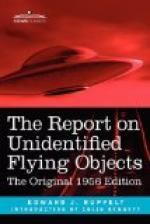To operate Project Blue Book, I had four officers, two airmen, and two civilians on my permanent staff. In addition, there were three scientists employed full time on Project Bear, along with several others who worked part time. In the Pentagon, Major Fournet, who had taken on the Blue Book liaison job as an extra duty, was now spending full time on it. If you add to this the number of intelligence officers all over the world who were making preliminary investigations and interviewing UFO observers, Project Blue Book was a sizable effort.
Only the best reports we received could be personally investigated in the field by Project Blue Book personnel. The vast majority of the reports had to be evaluated on the basis of what the intelligence officer who had written the report had been able to uncover, or what data we could get by telephone or by mailing out a questionnaire. Our instructions for “what to do before the Blue Book man arrives,” which had been printed in many service publications, were beginning to pay off and the reports were continually getting more detailed.
The questionnaire we were using in June 1952 was the one that had recently been developed by Project Bear. Project Bear, along with psychologists from a midwestern university, had worked on it for five months. Many test models had been tried before it reached its final form—the standard questionnaire that Blue Book is using today.
It ran eight pages and had sixty-eight questions which were booby-trapped in a couple of places to give us a cross check on the reliability of the reporter as an observer. We received quite a few questionnaires answered in such a way that it was obvious that the observer was drawing heavily on his imagination.
From this standard questionnaire the project worked up two more specialized types. One dealt with radar sightings of UFO’s, the other with sightings made from airplanes.
In Air Force terminology a “flap” is a condition, or situation, or state of being of a group of people characterized by an advanced degree of confusion that has not quite yet reached panic proportions. It can be brought on by any number of things, including the unexpected visit of an inspecting general, a major administrative reorganization, the arrival of a hot piece of intelligence information, or the dramatic entrance of a well-stacked female into an officers’ club bar.
In early June 1952 the Air Force was unknowingly in the initial stages of a flap—a flying saucer flap—the flying saucer flap of 1952. The situation had never been duplicated before, and it hasn’t been duplicated since. All records for the number of UFO reports were not just broken, they were disintegrated. In 1948, 167 UFO reports had come into ATIC; this was considered a big year. In June 1952 we received 149. During the four years the Air Force had been in the UFO business, 615 reports had been collected. During the “Big Flap” our incoming-message log showed 717 reports.




